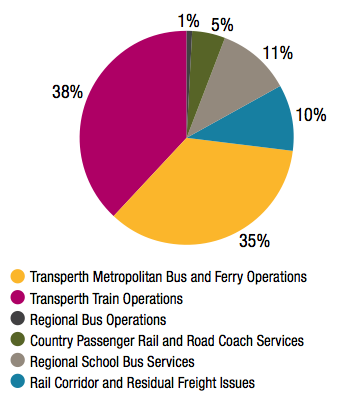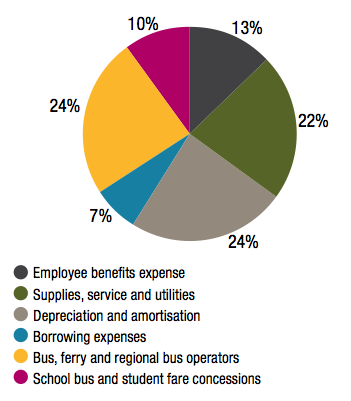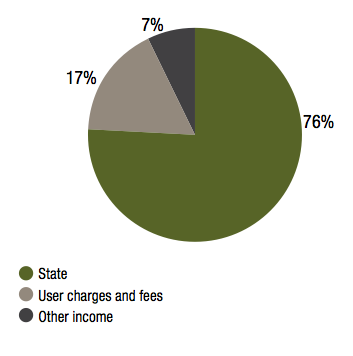Service and Financial Achievements
During the financial year 2010-11, the PTA has delivered public transport services to the people of Western Australia worth $1003.7 million. The graph below shows how these funds were spent across each service. Refer to the individual sections of Review of Performance by mode for further details on expenditure by services. Total revenue and funding received during the year amounted to $965.7m.
Expenditure by Service
Total Expenditure by Type
Revenue and Funding Sources
Financial Targets: Actuals compared to budget targets
The following table provides a comparison of the financial targets and outcomes against criteria included in the Resource Agreement between the Chief Executive Officer, Minister for Transport and the Treasurer.
|
2010-11 Target (1) $’000 |
2010-11 Actual $’000 |
Variation (2) $’000 |
||
|---|---|---|---|---|
| Total cost of services | 929,594 | 1,003,704 | (74,110) | Note 2.1 |
| Net cost of services | 724,951 | 772,404 | (47,453) | Note 2.2 |
| Total Equity | 3,456,378 | 4,588,178 | ( 1,131,800) | Note 2.3 |
| Net increase/(decrease) in cash held | 20,713 | 40,792 | (20,079) | Note 2.4 |
|
Number of FTE’s |
Number of FTE’s |
Number of FTE’s |
||
| Approved Full Time equivalent | 1,474 | 1,444 | 30 | Note 2.5 |
Notes
- As specified in the 2010-11 Budget statements
-
Explanation of variations:
(2.1) Increase in Total Cost of Services reflects Cabinet and EERC Budget approvals during 2010-11, the increase is mainly due to depreciation cost following the revaluation of the rail freight network ($75.6 million).
(2.2) Increase in Net Cost of Services reflects increases in Total Cost of Services offset by a $26.7 million increase in revenue, mainly due to:
- Fare revenue $13.6 million;
- Rental revenue $2.6 million;
- Revenue from external works and interest $3.0 million;
- Revenue from Department of Education for services to Intensive English Language centres $2.6 million;
- Revenue from infringements, service contributions and advertising $4.1 million.
(2.3) The variation is mainly due to a revaluation of freight network infrastructure in 2009-10.
(2.4) The increase in cash held is mainly due to cash balances held:
- for increased provisions on the balance sheet $10.0 million;
- for funding of asset investment in later years $10.6 million.
(2.5) The variation to the approved FTE staff level is mainly due to the difficulty in recruiting Transit Officers. Train security was maintained by use of CCTV and contracted security services.
Summary of Key Performance Indicators: Actual compared to budget targets
|
2010-11 Target |
2010-11 Actual |
Variation | |
|---|---|---|---|
Outcome: Accessible, Reliable and Safe Public Transport System |
|||
Key Effectiveness Indicators |
|||
Use of public transport - passengers per service kilometre: |
|||
|
1.43 | 1.43 | 0.00 |
|
3.85 | 4.11 | 0.26 |
|
14.16 | 13.64 | (0.52) |
|
0.872 | 0.850 | (0.022) |
|
0.230 | 0.235 | 0.005 |
|
0.070 | 0.066 | (0.004) |
Accessible Public Transport: |
|||
| The proportion of street addresses within the Perth Public Transport Area which are within 500 metres of a Transperth stop providing an acceptable level of service | 81.0% | 83.8% | 2.8% |
Metropolitan and regional passenger services reliability: |
|||
|
85.0% | 85.1% | 0.1% |
|
95.0% | 95.7% | 0.7% |
|
98.0% | 99.2% | 1.2% |
Country passenger rail and road coach services reliability: |
|||
|
90% | 75% | (15%) |
|
90% | 95% | 5% |
|
95% | 92% | (3%) |
|
95% | 98% | 3% |
|
95% | 98% | 3% |
Regional School Bus Services reliability: |
|||
|
97% | 99% | 2% |
Level of overall customer satisfaction - customer satisfaction index: |
|||
|
83% | 82% | (1%) |
|
90% | 88% | (2%) |
|
98% | 96% | (2%) |
|
92% | 90% | (2%) |
Customer perception of safety - independent external surveys: |
|||
|
96% | 99% | 3% |
|
97% | 98% | 1% |
|
65% | 72% | 7% |
|
75% | 76% | 1% |
|
97% | 97% | 0% |
|
98% | 99% | 1% |
|
68% | 73% | 5% |
|
82% | 82% | 0% |
Level of notifiable safety occurrences - notifiable occurrences: |
|||
|
0.25 | 0.19 | (0.06) |
|
0.90 | 0.69 | (0.21) |
|
9.00 | 6.63 | (2.37) |
|
32.80 | 24.69 | (8.11) |
|
13 | 19 | 6 |
Outcome: Protection of the long-term functionality of the rail corridor and railway infrastructure: |
|||
|
Nil | Nil | Nil |
Key Efficiency Indicators |
|||
Service 1: Metropolitan and Regional Passenger Services |
|||
| Average cost per passenger kilometre | |||
|
$0.81 | $0.83 | $0.02 |
|
$0.43 | $0.40 | ($0.03) |
|
$1.15 | $1.15 | $0.00 |
| Average cost per 1,000 place kilometres | |||
|
$78.33 | $80.91 | $2.58 |
| Total passenger place kilometres (millions) | |||
|
194.10 | 190.90 | (3.20) |
Service 2: Country Passenger Rail and Road Coach Services |
|||
| Average cost per passenger kilometre | |||
|
$ 0.48 | $0.43 | ($0.05) |
|
$ 0.24 | $0.22 | ($0.02) |
Service 3: Regional School Bus Services |
|||
| Average cost per contracted kilometre: School Bus Services | $3.56 | $3.39 | ($0.17) |
Service 4: Rail Corridor and Residual Freight Issues |
|||
| Total cost of managing the rail freight corridor and residual freight issues (f) | $31,643,000 | $100,346,000 | $68,703,000 |
Note: For more explanations on the variation, please refer to the section Audited Key Performance Indicators.
- The Prospector OTR result was below target as a result of disruptions in services due to track repairs, speed restrictions, signal failures and train crossing delays due to increased traffic.
- Category ‘A’ incidents per million passenger boardings and per million train kilometres were 25.55% and 23.03% lower than target.
- Regional School Bus Services notifiable occurrences were above target; approximately 68.42% of the accident cases occurred through no fault of the school bus driver. No fatalities or serious injuries were recorded.
- The Transperth Train services cost per passenger kilometre in 2010-11 was 6.81% below target mainly due to the 5.68% increase in passenger kilometres compared to the previous year.
- The average cost per 1000 place kilometres for regional bus services was above target by 3.29%, due to the additional maintenance costs incurred by intra-town services and the costs associated with the reinstatement of the Kalbarri and Monkey Mia feeder services
- The cost of managing the rail corridor and residual freight issues was significantly higher than target and the previous year’s result following the revaluation of the freight network which increased depreciation costs significantly by $76 million.


